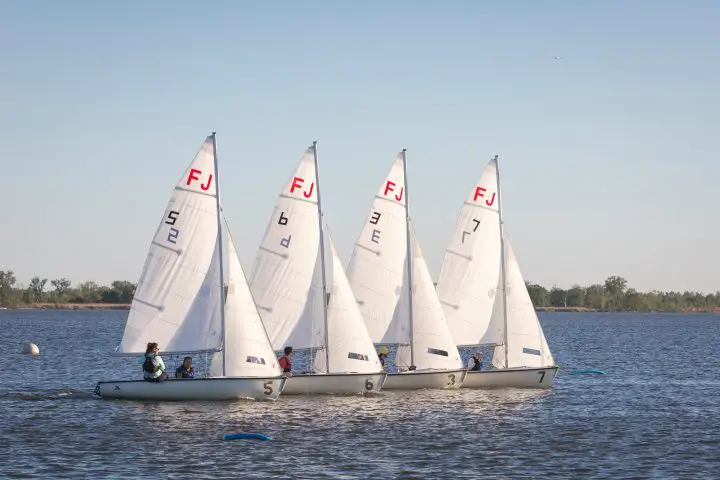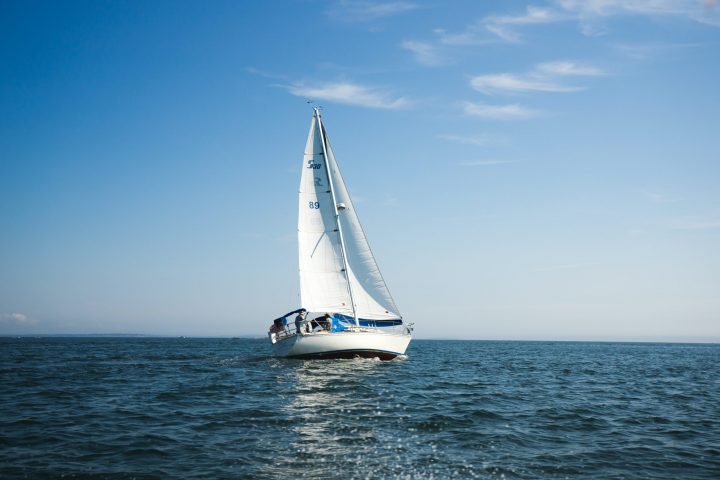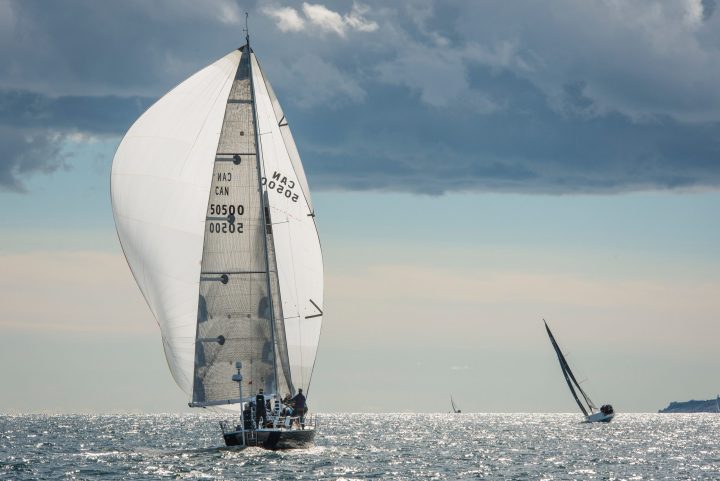The points of sail refer to the boat’s current angle compared to the wind’s direction. For example, if you are headed directly into the wind, you are “in irons.” If you are headed away from the wind, you are “running.” Here’s a look at the basic points of sail and how they apply to the typical cruising boat.
Table of Contents

Different Points of Sail
You might have heard of the sailing terms reach, run, and close-hauled. Sailors use the points of sail to discuss their current sailing direction and communicate changes.
For example, if a boat is sailing on a beam reach, the skipper might ask the helmsperson to try a close haul. The helmsperson will know that instead of keeping the wind directly from the boat’s beam, they need to sail upwind.
Points of Sail Degrees
A sailboat could be pointed any of 360 degrees. When thinking of the points of sail, the wind is coming from 0 degrees. If you are headed directly into the wind, you are in irons. If you are headed 90 degrees off the wind, you are on a beam reach.
Port Tack and Starboard Tack
If the wind is coming from the boat’s port side, this is a port tack. If the wind is coming from the starboard side, this is a starboard tack.
If you are the helmsperson looking forward towards the bow, the boat’s starboard side is on your right. The port side of the boat is on your left.
Irons Sailing
When you are heading directly into the wind, you are in irons. It is aerodynamically impossible to actually sail into the wind.
If a skipper keeps the boat in irons, the sailboat will slow down, lose forward momentum, and eventually stop. When the boat slows below about two knots, it also loses steerage. The rudder is no longer effective when the vessel is completely in irons.
Skippers might purposefully put the boat in irons to rescue crew overboard, pick up a mooring, or dock the boat.
If a boat is turning into the wind and wants to keep sailing, skippers avoid irons sailing. Because the boat slows down so quickly and loses steerage, it can be hard to get the sailboat moving again.
Boaters get in irons when they don’t tack fast enough. For example, if a sailor is sailing upwind and wants to switch from a starboard tack close haul to a port tack close haul, they will execute the tack. The boat needs to move across the wind as quickly as possible and keep forward momentum.
The skipper must recover if a boat doesn’t tack fast enough through the wind and ends up in irons. The skipper can backwind the jib to get some momentum going. Sometimes moving the rudder will help enough to get the boat sailing again.
Because the boat cannot keep sailing in irons, this point of sailing is also called “No Go” or “No Sail Zone.” While it is typically less than 45 degrees off the wind, each boat has a different “No Go Zone.” Some boats sail better into the wind, and some can’t sail any closer than 65 degrees off the wind.
Close Hauled Sailing
When a boat is sailing close-hauled, it is heading towards the wind but not directly into it. This point of sail lies about 45 degrees off the wind. Being close-hauled is also referred to as beating into the wind or simply “beating.” When you are close hauled, you are very aware of the strength of the wind. Waves are more impactful and may be hitting the boat and make for a wet ride.
Sailors must be careful not to get too close to the wind on a close haul. Their sails will luff and be less efficient if they head up into the wind too much.
Sailors can be close-hauled on a port or starboard tack.

Close Reach Sailing
Close reach sailing is a popular and fast point of sail. Greater apparent wind speeds equal greater sailing speeds. This point of sail is more comfortable than a close haul sail setting.
Sailors can be on a close reach on a port or starboard tack.
Beam Reach Sailing
Sailing on a beam reach is often a sailor’s favorite sailing point. The boat is sailing 90 degrees off the wind, and the wind is coming directly onto the boat’s beam. Sailing on a beam reach is fast. A boat will heel over the most on a beam reach.
You can be on a beach reach on a port or starboard tack.
Broad Reach Sailing
When you are sailing on a broad reach, you are sailing downwind. Instead of using lift to move the boat, the boat now relies on wind filling the sails. Because you experience less apparent wind on this point of sail, you will sail slower than if you were headed upwind.
You can be on a port or starboard tack when sailing broad reach.
Running
Running happens when the boat is sailing directly downwind. Dead downwind refers to the point of sail that’s 180 degrees off the wind. Sailors who are running often fly a big sail, such as a bright spinnaker, to catch as much wind as possible. Running downwind is a slower point of sail.
Sailors have to pay close attention to the wind direction as any change could cause the boat to jibe. When a sailboat jibes, the boom suddenly moves from one side of the boat to another. Depending on how much wind force is on the mainsail, a jibe can cause damage. It could also hit a crew member.
Because of the danger to the crew and the boat, running downwind is the most dangerous point of sail.

Sail Trim
Practicing the different points of sailing is a great way to practice perfecting your sail trim skills. As you move from sailing 45 degrees off the wind, to reach sailing, to sailing with the wind, you can practice easing and tightening the sheets for the most efficient sailing on each point of sail.
Sailing Upwind
When you are sailing upwind, the sheets will be sheeted in tightly. If you sail too close to the wind, the head sail will luff. If you are beating into the wind and tacking back and forth, you want to keep making headway towards your destination. Therefore, you want to keep sailing as close to the wind as your boat will allow.
Reach Sailing
You can sail on a close reach, beam reach, or broad reach. The more you sail downwind, the more you will loosen the sheets and let out your sails.
What is a Reach in Sailing?
If you’ve ever heard the sailing term reach, you must know that reaching is a popular point of sail. Sailing on a close, beam, or broad reach is forgiving. You won’t fall into irons or jibe the boat if you sail a few degrees off course.
Running
When you are running, you are downwind and sailing with the wind. Sailors will need to pay close attention to this point of sail to avoid an accidental jibe. The sails will be let out to their maximum capacity to catch as much wind as possible.
Changes in Wind Direction
When focusing on sail trim, skippers should monitor the direction of the wind and wind speed. Their tactics and sail trim will also have to shift if the wind shifts. A change in direction of the wind will be most noticeable on a close haul or when running.
Keep Sailing
Sailors often practice all the points of sail when taking lessons. Learning the different points of sail and the best sail trim means that sailors can efficiently sail from one place to another. Whether you are beating upwind, on a sailing reach, or running downwind, you can have fun while harnessing and managing the wind’s power.
Points of Sail FAQs
What are the 8 points of sail?
The eight points of sail include the different points of sail on both a port and starboard tack. These points of sail can be viewed as if on a clock.
In Irons
Close Hauled Port Tack
Beam Reach Port Tack
Broad Reach Port Tack
Running
Broad Reach Starboard Tack
Beach Reach Starboard Tack
Close Hauled Starboard Tack
What are the 3 points of a sail?
The three points of sail are close-hauled, reaching, and running.

